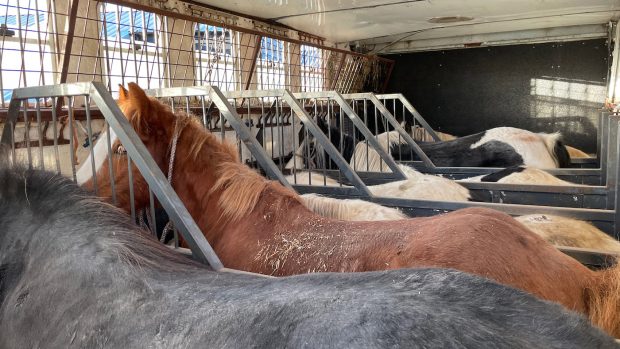Up again at 5.30am to drive on to the Hungary/Slovenia border. There’s another staging post here, and we can sit beside the road and watch for lorries — they should all pass along here.
The guys manning this staging post show us their logs — it’s the same story as at Zebrzydowice. Several hundred animals used to pass through here each month, now it’s little more than 100. So far in July, only two trucks with horses have stopped and unloaded for 24 hours.
The staging post staff report very few lorries stopping here from Romania, with the odd lorry from Belarus. For some reason there are far fewer stopping during the summer — their logs show that 17 passed by in February.
About one horse needs to be euthanased each month here — we don’t have a translator here but the guys indicate a broken leg.
Passing the time
Again, the staff are again very friendly and open. It must be such a boring job now — they’re sitting waiting in a small hut, and do 24-hour shifts either watching television or sleeping. They’re delighted to have company and, despite having no common language, we share a coffee and some chocolate.
Outside, the smile disappearing from her face, Jo says seeing the year-on-year drop in the numbers of trucks stopping after these countries joined the EU is “quite frightening”.
“We knew it was happening, but you really see it dropping year-on-year,” she says.
The fact that we haven’t come across any horses at these staging posts tells a tale, but I’m becoming anxious to see things that I’ve been reporting on during my five years at Horse & Hound — we’ve come all this way and seen nothing transported yet.
We spend the rest of the day waiting by the road, watching for trucks but see nothing. After supper, we visit the staging post again — their logs say most lorries stop at night — still nothing.
My first view of horses in transit
It’s 1am Thursday morning and I’ve been in bed for half an hour, trying to drop off to sleep. Jo calls me from her room — the guys at the staging post have rung to say a shipment of horses has turned up for feed and water. They won’t be staying long, so we’re there within 10 minutes.
Seeing these horses, I really wasn’t prepared for how I would feel. There are 26 donkeys, stuffed in with two foals with barely any headroom, in one trailer. In the second are 13 horses, tightly packed in between partitions, another foal. I had no idea how cramped the partitions are, and they look exhausted.
“They’re normally whinnying,” said Jo, “but you can tell how tired they are because they’re silent.”
This truck is from Romania, and unlike the heavy horses we saw in Poland, these are older, working horses and look more like what we’d see at home. I help to put hay through the bars, listen to them slurping the water. They’ve been on this lorry for 30 hours. I’m subdued and choked by emotions.
I can’t describe how I feel: these animals are completely at our mercy.
Finally get to bed past 3am.




